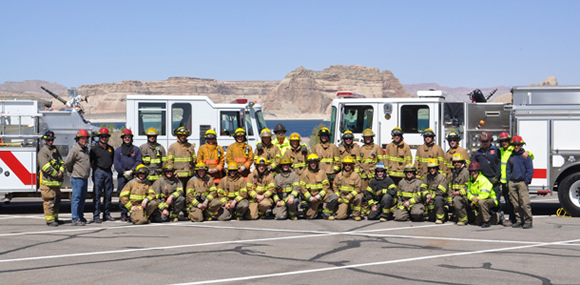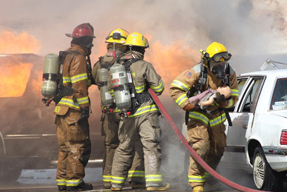Operational leadership emphasizes to students that no emergency incident will ever be completely safe. We have to recognize risks and be sure that the benefits of accepting that risk outweigh the dangers that are always inherent in emergency service


In support of the director’s plan, A Call to Action, operational leadership has been integrated into the NPS structural fire training curriculum at its class at the NPS Structural Firefighting Training Academy.
NPS engine companies in parks protect more than 10,000 buildings, over one-third of which are historic, and millions of visitors annually. As of 2011, more than 200 NPS employees staffed the bureau’s 49 fire stations, responding to hundreds of calls each year. One thing nearly all of these parks have in common is the critical need for them to work independently, because outside fire departments could easily take more than 30 minutes to respond. Because structural firefighting is so inherently dangerous, each fire department must do everything possible to reduce the hazards and dangers of the job to help prevent firefighter injuries and deaths. As a result, the NPS Structural Fire Training Academy has long seen the importance of incorporating safety initiatives and measures into its training curriculum. Operational leadership (OL) is the latest addition to safety initiatives and measures that also include personal accountability, team integrity, firefighter survival, risk-benefit analysis, seat belt pledge, mayday and evacuation procedures, and renewed emphasis on medicals and fitness requirements. “We have always taken great pride in using the agency’s training program as a mechanism to enhance operational safety at the park level,” reports Mark Gorman, the Structural Fire Operations Program manager.
“It only makes sense,” says Gorman. “By integrating OL into the class, it creates opportunities for employees to view real-time hazards, highlights ways to avoid complacency and allows students to expand their perspectives with mitigating hazards proactively.” Firefighters are broken into engine crews the first day of class and are taught to assess their safety concerns as individuals and as members of a team during the decision-making and risk assessment process. “We empower the students to incorporate the various tools and management practices of OL into their daily operations on the training ground and in the application of various live fire skill,” Gorman stated. “We want students to see the value of this process so that they will take it home to their parks and continue the practice.”
Structural firefighting frequently involves personnel from many divisions and pay scales. OL provides an excellent opportunity to bridge gaps between various work groups so they cooperate to mitigate hazards and safely stabilize emergency incidents. Furthermore, OL fosters open communication between the instructors and students so that all employees have the opportunity to voice their concerns and feel that safety is a shared responsibility. “As instructors we have performed many of these skills hundreds of times. It can be extremely easy to dismiss or overlook potential hazards that may be seen or perceived by the students. OL ensures that we collectively look at the action and discuss any hazards that might be present.”
Lead instructor Joe Lachowski says, “Operational leadership emphasizes to students that no emergency incident will ever be completely safe. We have to recognize risks and be sure that the benefits of accepting that risk outweigh the dangers that are always inherent in emergency services operations.” NPS structural fire instructors incorporate OL into live fire briefings and show the students how they have mitigated their safety concerns. Lachowski adds, “It is great to see the students take ownership in the evolution and feel more confident because they have worked through the risk mitigation process with their crew.”
“Whether you are talking about Operational Risk Leadership, the Everyone Goes Home Campaign, or the 16 Firefighter Life Safety Initiatives, we are talking about cultural change,” states Gorman. “We must do everything possible to not only empower employees to use these critical thinking skills, but also give them opportunities to see their application and value. Only then can we begin to change the culture.”
Last updated: October 14, 2016
